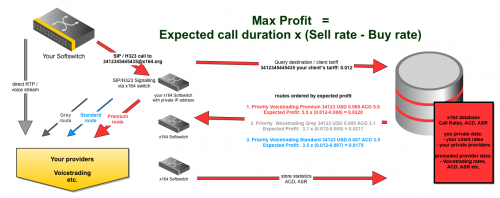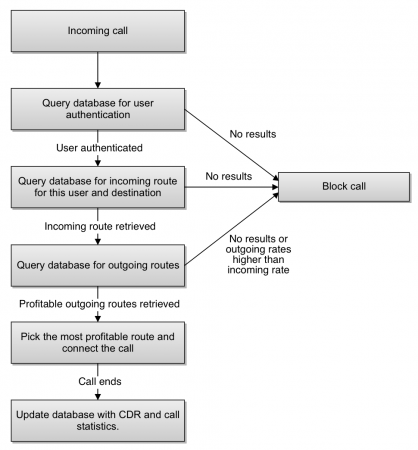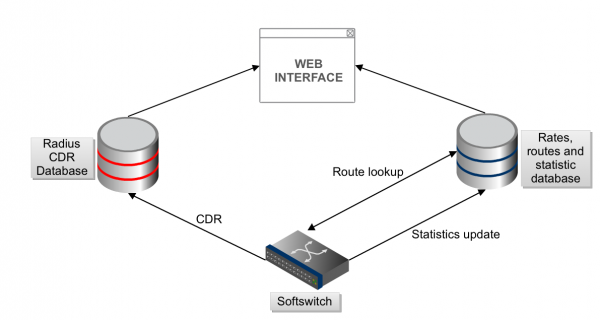Documentation
Here are a few links you can start from. In addition, you might want to take a look at the list of all categories or all pages.
x164 Introduction
x164 consists of a central database which holds private and public rate tables, statistics and route configurations. Many x164 switches connect to the central x164 database to retrieve routing information and to update the statistics in realtime. Softswitches are preferably, but not limited to, yate-based switches. Call detail records are collected with radius. Call details, statistics and the configuration screens are accessible by the web access.
x164 Call flow
When receiving a call, the softswitch queries the database for user authentication, which can be made either by IP or user/password. If the authentication is positive, a new query is issued to verify if the user is allowed to call the dialed number. Each user is linked to a profile that includes a set of allowed rates. Additionally, a prefix can be used to choose between different profiles when making a call. If no tariff is returned, the call is blocked.
Then the softswitch queries again the database to retrieve all the possible outgoing routes/rates for the call. With this information it calculates the most profitable rate, taking in account not only the routes cost, but also statistical information about the amount, success and duration of the calls made in the past using them.
When the call finishes the softswitch updates both the CDR database and the routes/rates/statistics database.
Web Access
x164 provides its members a web access to configure their settings, upload their rate tables and view call statistics. The interface and rating-engine is derived from CDRTool, which we modified heavily for speed and simplification.
Description
The call search offers access to call-detail-records CDRs. CDRs can be summarized, filtered for various statistics.
Selection fields
| Data source | Database where are the call details |
| Start time | Beginning of the range of time in search |
| Stop time | End of the range of time in search |
| Sip call / Sip source | Filter by the user ID, received from the customer or proxy |
| User agents / Media code | Filter by the format of the call |
| Sip Billing Party (username) | Search the calls of a subscriber |
| Sip Caller Party (From URI) | Filter using the ID received from the caller |
| Sip destination (Canonical URI) | Filter by destination of the call |
| Duration / Application / status | Filter selecting different call duration, media or the status of the call |
| Order by / Group by | Complements the search ordering results, change the limit of records to show, grouping these and if ReNormalize is marked the system recalculate the call prices |
Access to all data influencing the rating and routing. The rating data is contained in several tables which can be selected on the top-right side. The cost calculation of the calls stored in the system occurs in parallel and periodically using the values that the user introduce in this tables.
Customers table
Description
The Customers table shows details of your authorized customers who may send calls through the x164 system, the user can be authorized by trusted peer or subscriber and password.
Data fields
| Id | Automatically generated id field |
| Reseller | Numeric ID of reseller |
| Trusted Peer | Authorized IP address, in this case the user is authorized by IP |
| Domain | Not used |
| Dynamic_ip | Use dynamic IP when value set to 1 |
| Subscriber | Subscriber name in the format "user@domain" used as billing party in the rate process |
| Password | Password for authorized users |
| Profile | Profile name which links the customer to a profile in the profile table |
| Subscriber_out | In case subscriber also provides outgoing routes put outgoing subscriber name here to avoid looping calls |
| Blocked | Block the subscriber when value set to 1 |
| Pre_location | Parameters that are added before the called number in the outgoing message (possible values: SIP/00 to identify a SIP carrier with prefix of 00 in front of the e164 number) |
| Post_location | URL and parameters added to the called number in the outgoing message, e.g. @carrier.com |
| The outgoing route is defined as: pre-location + e164 number + post-location, e.g. SIP/004930123456789@carrier.com | |
| Expires | Expiration time of the dynamic IP |
| Formats | Possible codec formats separated by comma (possible values: g729, ulaw, alaw, t38) |
| rtpProxy | 1 activates rtp proxying for this route |
Carriers table
Description
The Carriers table has the details of your carriers to send calls to them.
Data fields
| Id | Automatically generated id field |
| Reseller | Numeric ID of reseller |
| Domain | Not used |
| Carrier_name | Carrier name in the format "user@domain" used as billing party in the rate process |
| Profile | Profile name which links the customer to a profile in the profile table |
| Blocked | Block the subscriber when value set to 1 |
| Pre_location | Parameters that are added before the called number in the outgoing message (possible values: SIP/00 to identify a SIP carrier with prefix of 00 in front of the e164 number) |
| Post_location | URL and parameters added to the called number in the outgoing message, e.g. @carrier.com |
| The outgoing route is defined as: pre-location + e164 number + post-location, e.g. SIP/004930123456789@carrier.com | |
| Line | Section identifier from accfile.conf, this can be used instead of pre-location, post-location |
| Formats | Possible codec formats separated by comma (possible values: g729, ulaw, alaw, t38) |
| rtpProxy | 1 activates rtp proxying for this route |
Profiles table
Description
The profiles table shows the rate details assigned to customers which will be used to calculate the price of the call by x164 system,
Data fields
| Id | Automatically generated id field |
| Reseller | Numeric ID of reseller |
| Profile | Profile name which links the customer to the profile table |
| Rate | Rate name which identifies the rates used for this profile in the rates table |
| Starthourweek | Start hour in the week of this tariff (possible value range 0 - 167) 0 hour is Sunday 0:00 hour in local time |
| Endhourweek | End hour in the week of this tariff (possible value range 0 - 167) 0 hour is Sunday 0:00 hour in local time |
| Penalty | Constant price added to this rate. Used to penalize a tariff. |
| Timezone | Timezone must reflect the local time of the tariff in the rating profile table. The setting is used to correct the CDR timestamps coming from the softswitch which should be in GMT time. Use timezone identifier. |
| Incr | Used to consider the duration of the call in increments (default 1 second) |
| Min_Dur | Minimum duration time charged of the call, only activated when the call is successful |
| Curr_code | Currency used in iso format (EUR, USD ...), if you want use your own values the format should be iso and adding reseller number |
| Carrier | Role of the subscriber in the call: IN when is the caller, CARRIER, DIDCLIENT when is the called, DIDRANGE is used and necessary to define a range of own numbers defined by DIDCLIENT |
| Tech_Prefix | Technical prefix used to identify incoming rate table. Different tech prefixes allow to link several rate tables to one incoming customer, e.g. to let the client chose dynamically grey, standard, premium rate tables |
Rates table
Description
The rate table shows details to calculate the price by x164 system according to valid tariff and destination
Data fields
| Id | Automatically generated id field |
| Reseller | ID number |
| Rate | ID of the rate |
| Destination | Destination number to this rate |
| Region | Region of this number |
| Description | Description of the destination to the number |
| App | Application Type: audio, sms |
| Conn | Price of the call connection |
| Price | Price per minute |
| Conn In | Cost of the call setup, to calculate the profit of the call |
| Price In | Cost per minute, to calculate the profit of the call |
| Start Date | The start time of the rate |
| End Date | The end time of the rate |
| Blocked | Lock indicator of the rate |
| Billtime_sum | Sum of billed time of this rate |
| Ringtime_sum | Sum of ring time of this rate |
| Setuptime_sum | Sum of setup time (until ringing) of this rate |
| Calls_count | Number of calls of this rate |
| Success_count | Number of connected calls |
| Acd_short | Short-term average call duration, updated after each call with acd_short = ((5 * acd_short) + _billtime)/6, |
| Acd_avr | Long-term average call duration, updated after each call with acd_avr = (acd_short + (billtime_sum / success_count)) / 2 |
Gateways table
Description
The gateways table serves to identify the IP address of the switches used by the reseller.
Data fields
| Id | Automatically generated id field |
| Reseller | ID number |
| Gateway | IP address of the switch |
| Secret | Switch's password |
DIDclients table
Description
The DIDclients table show the DID clients with their numbers.
Data fields
| Id | Automatically generated id field |
| Reseller | ID number |
| DID_number | Number of the client |
| DID_subscriber | Subscriber who belongs this number |
Currencies table
Description
The currencies table shows the currencies that use by x164 system to can evaluate in routing process to look for the most appropriate route.
Data fields
| Id | Automatically generated id field |
| Reseller | ID number |
| Domain | Not used |
| Currency | Currency id in the system, use ISO format adding reseller number to be unique in the system |
| Curr_rate | Value of the currency, against the euro |
Quota table
Description
The quota table stores the billed sum of calls made by each subscriber. The table allows to set a monthly quota limit. When the limit is reached the subscriber is blocked. The usage is reset at the beginning of each month. Un-blocking of subscribers has to be done manually.
Data fields
| Id | automatically generated id field |
| Reseller | ID number |
| Subscriber | Subscriber name in the format "user@domain" |
| Domain | Subscriber domain |
| Quota | Quota limit per month |
| Notified | Date on which the system detected the exceeded limit |
| This Month | Monthly cumulative consumption |
| Today | Daily cumulative consumption |
Softswitch
The x164 switch is based on yate, In its basic configuration the switch can handle SIP and H323 calls. IAX, ISDN, SS7 calls are theoretically possible. Users can activate further yate modules to extend the possibilities. x164 members are encouraged to post their suggestions and ideas on the [ http://forum.x164.com/ forum]. The yate configuration is located in /usr/local/etc/yate.
Server settings
Time zone
The server running yate should have its timezone set to GMT time if the timezone setting is used in the rating customers table. The timezone setting in the rating customer table must reflect the local time of the tariff in the rating profile table. The timezone setting is used to correct the CDR timestamps coming from the softswitch. The Starthourweek and Endhourweek time ranges in the rating profiles table are always in local time.
CDR module - cdrbuild.conf
Description
This module builds the CDR messages (Call Details Record) which are used later in the radius module. Here are set the necessary attributes to create the correct CDR messages.
h323 Channel module - h323chan.conf
Description
This module give support to h323 protocol by using the open h323 library.
Mysql database module - mysqldb.conf
Description
This module is used to make the connection between yate and a MySQL database. Establishing the necessary parameters as host, port, database and password.
Radius module - yradius.conf
Description
This module give support to establish communication between Yate and FreeRADIUS, as well the ip address and port of the FreeRADIUS server. Are set the specific attributes to sent in the CDR message and are assigned the correct values.
Regexroute module - regexroute.conf
description
This module is used in addition to the register module, to assign values of different parameters in the call as the error messages or the formats to use in transcoding calls, used to route calls without using database.
Register module - register.conf
The register module defines the messsage handlers which are communicating with the x164 database. Message handlers "catch" internal yate messages, issue queries to the database and return the result back to yate. x164 is configured to use mysql stored-procedures as message handlers.
Authuser
Description
User_Auth is used to identify the subscriber.
Statement
PROCEDURE `proc_user_auth`( IN username VARCHAR(100), // username received in SIP INVITE IN domain VARCHAR(100), // domain name from caller IN address VARCHAR(25) // IP address and port of the received call IN password VARCHAR(25) // secret key for MySQL procedures in Yate )
Register
Description
This query handle register messages, add in database data of register users and the last time that the user was registered.
Statement
PROCEDURE `proc_user_register`( IN ip_host VARCHAR(30), // IP address received in SIP INVITE IN ip_port INT, // IP port received in SIP INVITE IN expires INT, // register expiration time IN authname VARCHAR(125) // authorized subscriber name corresponding in data base IN password VARCHAR(25) // secret key for MySQL procedures in Yate )
Unregister
Description
This query handle unregister messages initializing the data entered by register message.
Statement
PROCEDURE `proc_user_unregister`( IN authname VARCHAR(125) // authorized subscriber name corresponding in data base IN password VARCHAR(25) // secret key for MySQL procedures in Yate )
Engine timer
Description
The engine timer found that users have exceeded the time of registration and invalidate the dynamic_ip.
Statement
PROCEDURE `proc_user_enginer_timer`( IN password VARCHAR(25) // secret key for MySQL procedures in Yate )
Preroute
Description
Preroute checks whether an incoming route for the combination of IP address and called number or authname and called number exists. The caller is either identified by IP address or was identified by authname/password combination in authname procedure. If no incoming route exists the call is blocked.
Statement
PROCEDURE `proc_get_preroute`( IN authname VARCHAR(125), // authorized subscriber name corresponding in data base IN address VARCHAR(25), // IP address and port received in SIP INVITE IN called VARCHAR(100) // the called number, optionally with prefix IN password VARCHAR(25) // secret key for MySQL procedures in Yate )
Route
Description
This selects the possible outgoing routes according to the incoming parameters, looking for the best quality and profit.
Statement
PROCEDURE `proc_get_route`( IN usernameNobuy VARCHAR(125), // Subscriber_out found in incoming route to prevent call loops IN rtproxy_in TINYINT(4), // 0/1 flag to specify whether the rtp stream of the incoming call leg is proxied. IN realRateSell FLOAT, // (client) call rate found in preroute expressed in the base currency (EUR) IN called VARCHAR(100), // Called number (optionally with prefix). The prefix is not used. IN _format_in VARCHAR(255) // Codecs received in incoming call leg IN password VARCHAR(25) // secret key for MySQL procedures in Yate )
cdr_finalize
Description
This procedure computes the values of the call once finished to update the statistics in the system.
Statement
PROCEDURE `proc_cdr_finalize`( IN duration FLOAT, // the overall call duration IN billtime FLOAT, // the time the call was connected IN ringtime FLOAT, // duration of call ringing IN direction VARCHAR(10), // incoming or outgoing IN status VARCHAR(10), // if the call was connected or not IN rateidBuy BIGINT(20), // id of the rate for the outgoing call leg IN rateidSell BIGINT(20) // id of the rate for the incoming call leg IN password VARCHAR(25) // secret key for MySQL procedures in Yate )
RTP Channel module - yrtpchan.conf
Description
This module provides RTP and udptl transports for any technology that requieres it as SIP or H.323. The RTCP support is disabled.
SIP Channel module - ysipchan.conf
Description
This module give support to SIP protocol using the YASS library. Here also is posible select the value "expires" used in register.conf and the codecs enable to use.
Yate - yate.conf
Description
In this configuration file is selected the modules that are in use, and the parameter "timeout" limits the call duration as 2h.


